 Crooks and co-workers (University of Texas, USA) report the synthesis and characterization of Pt and Pd dendrimer-encapsulated nanoparticles (DENs) using the method of galvanic exchange. In the presence of either PtCl42− or PdCl42−, the less noble Cu DENs oxidize to Cu2+ leaving behind an equal-sized DEN of Pt or Pd, respectively. This methodology is shown to be much faster and giving higher yields than using the common synthetic route i.e. direct reduction with BH4−.Equally important, the detailed characterization presented demonstrates that the structure and composition of Pt and Pd DENs synthesized by direct BH4− reduction and galvanic exchange are indistinguishable.
Crooks and co-workers (University of Texas, USA) report the synthesis and characterization of Pt and Pd dendrimer-encapsulated nanoparticles (DENs) using the method of galvanic exchange. In the presence of either PtCl42− or PdCl42−, the less noble Cu DENs oxidize to Cu2+ leaving behind an equal-sized DEN of Pt or Pd, respectively. This methodology is shown to be much faster and giving higher yields than using the common synthetic route i.e. direct reduction with BH4−.Equally important, the detailed characterization presented demonstrates that the structure and composition of Pt and Pd DENs synthesized by direct BH4− reduction and galvanic exchange are indistinguishable.
Interested to know more? Why not download and read the article today! It’s recently been published in NJC and will be FREE to access for a period of 4 weeks.
Synthesis, characterization, and electrocatalysis using Pt and Pd dendrimer-encapsulated nanoparticles prepared by galvanic exchange
Surojit Pande, Michael G. Weir, Brian A. Zaccheo and Richard M. Crooks
New J. Chem., 2011, Advance Article DOI: 10.1039/C1NJ20083F, Paper.
Pt and Pd dendrimer-encapsulated nanoparticles prepared by galvanic exchange
Promising multifunctional two-photon chromophores for photodynamic therapy
Scientists from the Universities of Rennes and Nancy in France have developed dual-role biphotonic chromophores for photodynamic therapy (PDT) applications that retain fluorescence properties, thus enabling their 3-D localization and the selective irradiation of cancer cells when combined with targeting.
In their paper selected as ‘Hot Article’, the collaboration led by Mireille Blanchard-Desce presents the synthesis and photophysical study of “banana-shaped” chromophores where the nature of the conjugated backbone is modified by playing with the aromatic units (a complementary approach to that based on the incorporation of heavy atom substituents).
By optimizing the chromophore structure of a series of fluorene derivatives, the researchers were able to design photosensitizers exhibiting large two-photon adsorption (TPA) cross section in the biologically useful spectral region combined with singlet oxygen production.
‘This route allows to combine in a single biphotonic chromophore several features highly desirable for two-photon PDT: fluorescence (for localisation and subsequent localized irradiation), large and broad TPA responses in the spectral range of interest for bio-oriented applications (700-1000 nm), as well reasonable singlet oxygen sensitization ability’, says Mireille Blanchard-Desce.
The team is now working on developing nano-objects with very high TPA, that incorporate the biphotonic sensitizers.
Banana-shaped biphotonic quadrupolar chromophores: from fluorophores to biphotonic photosensitizers
Cédric Rouxel, Marina Charlot, Youssef Mir, Céline Frochot, Olivier Mongin and Mireille Blanchard-Desce
New J. Chem., 2011, Advance Article
DOI: 10.1039/C1NJ20073A, Paper
-
Interested? Why not read the full article now, FREE to access for a period of 4 weeks!
Why not submit your high impact research to us today or alternatively email us your suggestions.
Mild methodologies: electrochemical hydrogenolysis in ionic liquids
In this NJC Hot Article, Richard Compton and co-workers at the University of Oxford highlight novel electro-synthetic applications of ionic liquids.
The team has decorated carbon nanotubes with Palladium nanoparticles and used the composite material for the efficient electrochemical deprotection of common functional groups in ionic liquids (IL), thus demonstrating that Pd nanoparticles can be used for clean, efficient, safe electro- chemical hydrogenolysis in IL media.
This NJC article will be of interest to synthetic organic and inorganic chemists, electrochemists, material chemists, pharmaceutical chemists and process chemists alike.
- Why not take a look and read the article now, FREE to access for a period of 4 weeks!
- To keep up-to-date with NJC’s latest developments, subscribe to our RSS feed.
Palladium nanoparticle-modified carbon nanotubes for electrochemical hydrogenolysis in ionic liquids
Yao Meng, Leigh Aldous, Ben S. Pilgrim, Timothy J. Donohoe and Richard G. Compton
New J. Chem., 2011, Advance Article
DOI: 10.1039/C1NJ20070D, Paper
Hot Article: A persistant (amino)(ferrocenyl) carbene
Ferrocene units confer a set of interesting properties to ligands for transition metal complexes, such as reversible redox- properties, planar chirality, or strong electron donating ability. While there are numerous examples of ferrocenylphosphines in which the ferrocene unit is directly bonded to the active coordination center – therefore maximizing its impact – attempts at stabilizing a carbene center using one or two ferrocenyl substituents had yet to prove successful.
Now, Guy Bertrand and colleagues at the University of California, Riverside, have successfully prepared the first stable carbene featuring a ferrocenyl unit directly bonded to the electron-deficient center, by using a pi-electron-donating substituent in the form of an amino group. The team was able to spectroscopically characterize and chemically trap the novel (amino)(ferrocenyl)carbene compound.
Such work is envisioned to open perspectives for the synthesis of new types of carbene ligands, and will be of high relevance to researchers in fundamental chemistry, organometallics, supramolecular chemistry, catalysis and beyond. Challenges ahead now include the further stabilization of such carbenes, via the preparation of cyclic ferrocenylaldiminium systems.
A persistent (amino)(ferrocenyl)carbene
Alan DeHope, Daniel Mendoza-Espinosa, Bruno Donnadieu and Guy Bertrand
New J. Chem., 2011, Advance Article
DOI: 10.1039/C1NJ20170K, Paper
Interested? Why not read this NJC Article selected as Hot, FREE to access until 6th of June 2011.
Let us know what you think and leave us a comment below!
This article will be part of the themed issue of NJC honouring the life and work of Prof. Didier Astruc, on the occasion of his 65th birthday – Coming soon.
News in Phosphole Chemistry – changing the course of intramolecular dimerisation
A new facet of Phosphole chemistry is being uncovered it this NJC Letter by François Mathey et al. at the Nanyang Technological University, Singapore. Phosphole rings have been known for a long time to dimerize via [4+2] cycloaddition whenever the phosphorus lone pair is oxidized or complexed. The [2+2] dimerization, on the contrary, is almost unknown.
Now, the authors show that a minor change in the structure of the bisphospholes derivative – i.e. P-O-P vs. P-S-P – completely suppresses the familiar (4+2)-cycloaddition in favour of the thermally forbidden (2+2) -cycloaddition despite considerable steric constraint.
Under solar light at room temperature, the tungsten pentacarbonyl complex of the P–S–P-linked biphosphole undergoes a [2+2] intramolecular cycloaddition. Then, this [2+2] dimer gives the original [4+4] dimer via a Cope rearrangement. This sequence stands in sharp contrast with the behavior of the corresponding P–O–P-linked biphosphole which undergoes a classical [4+2] cycloaddition.
This NJC Letter has been rated as Hot, and will be FREE to access for 4 weeks. Read it now and let us know what you think!
Intramolecular [4+2] versus [2+2] cycloadditions in P–X–P-linked biphospholes (X = O, S)
Matthew P. Duffy, Yuhan Lin, Liow Yu Ting and François Mathey
New J. Chem., 2011, Advance Article
DOI: 10.1039/C1NJ20087A, Letter
This article will be part of the themed issue of NJC honouring the life and work of Prof. Didier Astruc, on the occasion of his 65th birthday – Coming soon.
Meet Our Authors, May 2011
We are pleased to present a selection of our authors of the May issue of NJC. We thank each of them for accepting our invitation and having kindly taken some of their time to answer a few questions for us.
 Our first author is Dr. Cecilia Devi Wilfred who is Associate Professor at the Universiti Teknologi PETRONAS (Perak, Malaysia). Her current research interests are mainly focused on Ionic Liquids and their applications. In her NJC paper, Cecilia and co-workers report on the synthesis of low densities phosphonate-based nitrile ionic liquids.
Our first author is Dr. Cecilia Devi Wilfred who is Associate Professor at the Universiti Teknologi PETRONAS (Perak, Malaysia). Her current research interests are mainly focused on Ionic Liquids and their applications. In her NJC paper, Cecilia and co-workers report on the synthesis of low densities phosphonate-based nitrile ionic liquids.
The high reputation of the journal which is peer-reviewed to the highest standards was Cecilia’s motivation behind her submission to the journal.
Outside of the lab, Cecilia enjoys reading.
Effect of sulfonate-based anions on the physicochemical properties of 1-alkyl-3-propanenitrile imidazolium ionic liquids by Abobakr Khidir Ziyada, Mohamad Azmi Bustam, Thanapalan Murugesan and Cecilia Devi Wilfred, New J. Chem., 2011, 35, 1111-1116; DOI: 10.1039/C0NJ00950D.
Our next author is George E. Kostakis, Researcher at the Karlsruhe Institute of Technology (Karlsruhe, Germany). George’s research interests focus on coordination polymers, coordination cluster topology and water structures.
In this issue of NJC, George has authored the article Structural variation from 1D chains to 3D networks: A systematic study of coordination number effect on the construction of coordination polymers using the terepthaloylbisglycinate ligand by George E. Kostakis, Luigi Casella, Athanassios K. Boudalis, Enrico Monzani and John C. Plakatouras, New J. Chem., 2011, 35, 1060-1071; DOI: 10.1039/C0NJ01009J. “A systematic investigation of the coordination chemistry of terepthaloylbisglycinate with different metal centres which shows that apart from the coordination number of the metal centre, there are several factors affecting the network dimensionality for the room temperature reactions”, explains George who chooses NJC for the publication of this article due to the journal’s high quality and wide readership.
In his free time, George loves spending time reading, biking, listening to music and cooking.
 Hongchen Gu is Professor at the Nano Biomedical Research Center, Med-X Research Institute School of Biomedical Engineering from the Shangai Jiao Tong University (Shangai, China).
Hongchen Gu is Professor at the Nano Biomedical Research Center, Med-X Research Institute School of Biomedical Engineering from the Shangai Jiao Tong University (Shangai, China).
His current research interests are the synthesis of nanoparticles for biomedical applications, the magnetic properties studies of nanoparticles and drug and gene delivery nanoparticles-based systems.
In this NJC issue paper, Hongchen and co-workers describes the synthesis of a series of magnetite nanoparticle clusters and single nanoparticles by using polyols with different reductive abilities. “This study indicates that growth kinetics has great impact on the secondary structure of magnetite nanoparticles and determines the morphology evolution of the nanoparticles” says Hongchen.
Facile synthesis and morphology evolution of magnetic iron oxide nanoparticles in different polyol processes by Changming Cheng, Fangjie Xu and Hongchen Gu, New J. Chem., 2011, 35, 1072-1079; DOI : 10.1039/C0NJ00986E.
“NJC was chosen as it is a high impact and fast editing journal in chemistry”
Reading and playing table tennis are Hongchen’s favorite activities.
Closing this month’s authors selection, Neerish Revaprasadu is Professor of Inorganic Chemistry and Chair of Nanotechnology at the University of Zululand (Kwadlangezwa, South Africa).
His current research interest is inorganic materials chemistry and he has authored in this NJC issue the paper Heterocyclic dithiocarbamates: precursors for shape controlled growth of CdS nanoparticles by Linda Dyorisse Nyamen, Viswanadha Srirama Rajasekhar Pullabhotla, Adeola Ayodeji Nejo, Peter Ndifon and Neerish Revaprasadu, New J. Chem., 2011, 35, 1133-1139; DOI: 10.1039/C1NJ20069K.
“The journal has a good readership and is multidisciplinary. The feedback from the editors is always helpful and constructive and also very quick. I have always had a good experience with NJC.”
Out of the lab, Neerish’s favorite activities are reading and travelling.
NJC Issue 5, 2011 now published !
We welcome you to NJC’s May issue, out now. This month again NJC publishes high-quality, original and significant research works that cover an impressive range of topics including: electrochemistry, soft matter, nanoparticles, polymers, sensing, synthetic chemistry, crystallographic engineering, supramolecular chemistry, homogenous catalysis, computational chemistry and photochemistry.
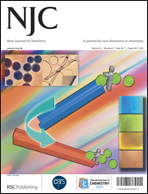
The outside front cover highlights our latest Focus article by Jiannian Yao (Institute of Chemistry, Chinese Academy of Sciences) on composite nanomaterials fabricated from organic luminescent molecules, which provide opportunities for both theoretical studies on the inter-molecular energy transfer process and practical applications in light-emitting materials, optical waveguides, optical memory media and chemical sensors.
Organic composite nanomaterials: energy transfers and tunable luminescent behaviors, Chuang Zhang, Yong Sheng Zhao and Jiannian Yao, New J. Chem., 2011, 35, 973-978, DOI: 10.1039/C1NJ20012G.
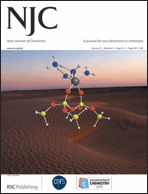
NJC issue 5, 2011 inside front cover was produced by Odile Eisenstein and Elsje Alessandra Quadrelli from the University of Montpellier and the University of Lyon, respectively. In this research article, the authors describe a joint experimental and computational study of the reaction of NH3 with a silica supported amido–imido Ta complex.
Top Ten most accessed NJC articles in March
The latest top ten most downloaded NJC articles
See the most-read papers of March 2011 here:
DOI: 10.1039/C0NJ00623H
DOI: 10.1039/C0NJ00718H
DOI: 10.1039/C0NJ00937G
DOI: 10.1039/C0NJ00825G
DOI: 10.1039/C0NJ00275E
DOI: 10.1039/C0NJ00770F
DOI: 10.1039/C0NJ00712A
DOI: 10.1039/C0NJ00836B
DOI: 10.1039/C0NJ01027H
DOI: 10.1039/C1NJ20012G
Meet Our Authors – April 2011
Here is a selection of author profiles from the April issue of NJC. The editorial team would like to warmly thank them for accepting the invitation, giving us the opportunity to know some of our fellow chemists a little better.
Our first author is Professor Helena Grennberg, who is based at the faculty of Uppsala University (Sweden). Her current research interests are mainly focused on the chemistry of carbon allotropes (C60, nanotubes, graphene).

In her NJC paper, Helena and coworkers report on the stirring-induced aggregation of graphene in suspension that leads to folding/scrolling and reversible agglomeration (capture) of thin flakes. Such a solution-based process could be useful for the preparation of graphene-containing thin films and composites.
The broad scope of NJC, yet with the correct topical focus for carbon allotrope chemistry, was Helena’s motivation behind her submission to the journal.
Outside of the lab, Helena enjoys skiing and orienteering. “But my family is top priority, including ‘mom’s taxi’ to all the activities my children take part in”. When asked for an alternative career path if not a scientist, “Designer? Chef?”, said Helena, immediately adding, “being a scientist, in particular an experimental organic chemist comprises both and much more, it is the best I can think of!”
Stirring-induced aggregation of graphene in suspension by Wenzhi Yang, Erika Widenkvist, Ulf Jansson and Helena Grennberg, New J. Chem., 2011, 35, 780–783; DOI: 10.1039/c0nj00968.
Sebastiano Campagna is Professor of Physical Chemistry at the University of Messina, Italy. He is currently working in the fields of photochemistry and photophysics of supramolecular systems, photoinduced electron and energy transfer, artificial photosynthesis, and molecular logics. His paper is the fruit of a collaboration with Raymond Ziessel, working in the University of Strasbourg, a well-known specialist in fluorescent Bodipy dyes. They report on a hybrid bodipy-bipyridine dye that features part of the properties of D-latch circuits by integrating two logic gates, a NOR and an INHIBIT gate, with both gates sharing the same inputs.
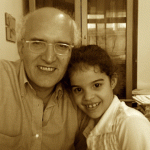
“We submitted this work to NJC because of the high quality of the articles published in the journal, its large diffusion and multidisciplinary nature which guarantees for a broad an diverse readership.”
Playing guitar and travelling with his daughter are Sebastiano’s favorite activities. If he could not be a scientist, he would be a musician or a novel writer.
Molecular logics: a mixed bodipy–bipyridine dye behaving as a concealable molecular switch by Fausto Puntoriero, Francesco Nastasi, Thomas Bura, Raymond Ziessel, Sebastiano Campagna, and Antonino Giannetto, New J. Chem., 2011, 35, 948-952; DOI: 10.1039/c0nj00770
The next author is Gui Yin, Associate Professor at the Key Laboratory of Analytical Chemistry for Life Science, Ministry of Education of China, School of Chemistry & Chemical Engineering, Nanjing University. His research group is currently working on photoelectric materials, carbon materials chemistry and synthesis of various chemosensors for heavy transition metal ions. In collaboration with research groups from the School of Electronic Science and Engineering and the School of Physics in the same University, this NJC paper describes a new organic molecule based on pyrene, which shows remarkable fluorescence turn-on behavior towards Ag+. The very low detection limit obtained with this system complies with the standards of US EPA and World Health Organization (WHO) for drinking water.

“NJC is our preferred journal because of its high quality and wide readership. During the submission process, the fast publishing time and high efficiency gave me a deep impression.”
Outside the lab, Gui appreciates reading Chinese ancient poetry. He also spends plenty of time staying with his family and they often go on a trip together. Because Gui enjoys very much the delight of the peaceful country life, if he had another choice, he would like to be a writer or farmer.
Fancy submitting an article to NJC? Then why not submit to us today or alternatively email us your suggestions.
NJC Issue 4 out now !
We invite you to visit the April issue of NJC.
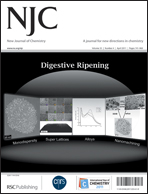
A perspective article by B. L. V. Prasad and D. S. Sidhaye (National Chemical laboratory, Pune, India) features on this month’s front cover. In this review article, the digestive ripening procedure is reviewed, discussed and its utility spanning the preparation of monodispersed nanoparticles, alloy nanoparticles, superlattice structures and the most interesting nano-machining is demonstrated.
Many manifestations of digestive ripening: monodispersity, superlattices and nanomachining, Deepti S. Sidhaye and B. L. V. Prasad, New J. Chem., 2011, 35, 755-763, DOI: 10.1039/C0NJ00359J (Perspective)
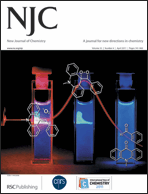
The inside cover was produced by R. Beckert and W. J. Baader and co-workers (a collaboration from teams in Germany and Brazil), presenting an uphill energy conversion process using 1, 2-dioxetanes.
Chemiluminescence-based uphill energy conversion, Luiz Francisco Monteiro Leite Ciscato, Dieter Weiss, Rainer Beckert, Erick Leite Bastos, Fernando Heering Bartoloni and Wilhelm Josef Baader, New J. Chem., 2011, 35, 773-775, DOI: 10.1039/C0NJ00843E (Letter, Hot paper)
In this issue, also check out :
• the perspective article by D. Astruc on the assembly, properties, functions and multiple applications of ferrocenyl dendrimers from small to giant sizes.
Ferrocenyl dendrimers: multi-electron redox reagents and their applications, Didier Astruc, New J. Chem., 2011, 35, 764-772, DOI: 10.1039/C0NJ00875C (Perspective)
You can access and read the whole issue 4 here.













